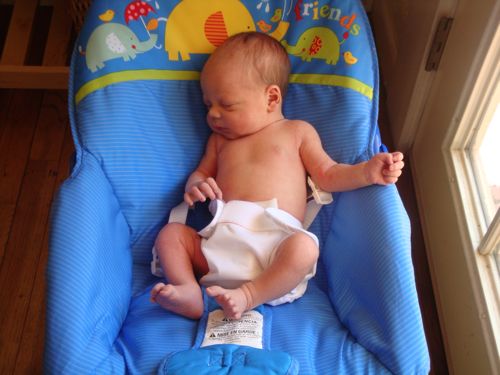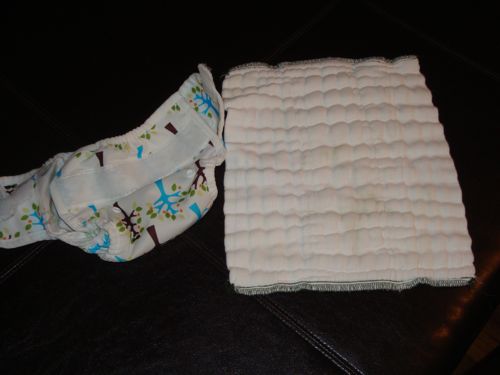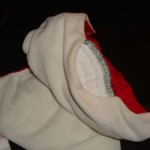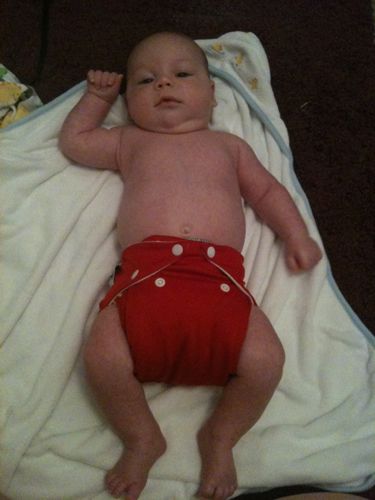Cloth Diapers 101
Updated 3/26/2011 when I learned about shaking your pocket diapers and Econobum covers
As soon as people find out that you are using cloth diapers, they have one of two reactions. Either they think you’re nuts, or they think it’s amazing and they start asking you more questions about what kinds to use. If you are one of those who thinks I’m crazy, you can go back and read my post from earlier in the year on why I chose to use them. If you are one of those with questions, read on, my friend!
There are three basic types of cloth diapers on the market. I’m going to try to address all three and give my experience with each and tell what I think are the pros and cons. I’ll also try to recommend brands that I like, but keep in mind that there are a LOT of cloth diapers on the market. The best way to find out what you like is to try a few and see what works best for you and your family. I recommend visiting the following sites as you research options: Green Mountain Diapers, Cotton Babies, Jillian’s Drawers, and GroVia. The sites are full of great information, but are also great places to do your shopping.
Type 1: Covers and Pre-folds

Newborn Prorap cover with Unbleached Indian cotton prefold in infant size.
These are the new and improved version of the traditional cloth diapers that our parents used and the first type I was exposed to. My sister started off cloth diapering her second child using Cloth-eez prefold diapers and Bummi’s super snap covers she ordered from Green Mountain Diapers. I started Grayson off in tiny newborn Indian cotton prefolds and ProRap covers with velcro that were purchased from the Little Lions web site. Back in the old days, you had a giant piece of cotton that you folded up to fit your baby, pinned with those GIANT safety pins, and then covered with plastic pants. These days, it’s so much easier. The cotton comes pre-folded and stitched into various sizes to fit your baby. Also, pins aren’t needed. You can use Snappi fasteners or simply fasten a water proof cover over the prefold. The Snappis are a great option because they give a better fit to your baby which helps to contain messes.
I liked the ProRap covers for a couple of reasons. They fit the tiny baby and held in the messes really well. The newborn size scoops down in the front to allow the belly button to stay dry. I also like the ease of the velcro closures, though snaps are an option in some sizes. In addition, they seem to be one of the cheapest covers out there! Bummis also come with velcro, but my sister chose the snaps. Lots of people prefer the snaps because it’s harder for the baby to remove his own diaper than with velcro. However, I don’t think you get as good of a fit, and the solution to diaper removal is to put a onesie or pants on your baby. Simple!

A tiny Grayson in a ProRap diaper cover.
When Grayson got a little bigger, I switched to Thirsties Duo Wrap covers and larger prefolds. The Duo Wraps come in two sizes, both are adjustable. I like that the two sizes give a better fit as your baby grows. (Thirsties also sells sized diapers that don’t adjust.) There are lots of “One size” cover options out there, but some complain that they tend to be too big on a little baby and too small on a big one. It’s a matter of preference and budget as you decided whether to replace your covers for each size or choose “One Size” diapers.

This is a Size One in the Thisties Duo Wrap. This size fit Grayson until he was about 5 months old. At almost 6 months, the Size Two is a better fit..
Recently, I became aware of Econobum diapers, made by Cotton Babies (they also make Bum Genius). These diapers are amazingly affordable. They are one-size covers that run less than $10 a piece. Depending on which package you choose, you can stock your diaper collection with 2 dozen prefolds and 6-8 covers for right around $100! These diapers have a great fit and come in 4 color options. The covers aren’t designed to last through multiple children, but the prefolds are some of the nicest I’ve seen.
There is also the option of wool “soakers” to use over the prefolds. Wool naturally deodorizes and is very absorbent. It also allows the skin to breathe, and doesn’t make a baby hot like you might expect. I haven’t personally used wool covers, but I made a few for my my sister who loved them on her baby in the summer time when she dressed him in nothing but a diaper and a t-shirt. (See the post on this knitting project.) She moved away from the in the winter because his pants were getting damp. Wool covers are very expensive to buy, but REALLY cheap to make if you are a knitter.
Covers and prefolds are a good choice for many because this is by far the cheapest option (even if you get new sizes when your baby grows) and one that provides a good fit for babies because prefolds are chosen to fit to the size of your child. There are also several “hybrid” options that allow you to use reusable covers with disposable inserts. A friend of mine has had a great experience with GroVia diapers. I think I would like to try these myself, but I’ve already invested in other types!
For the time being, I have moved away from covers and prefolds because babies tend to feel wetness more, and this didn’t work for us. Grayson hated being wet and I was changing his diaper every 30 minutes! We may return to it when Grayson is ready for potty training, but, for now we’ve chosen to go another route.
Type 2: Pocket Diapers
Pocket diapers provide a barrier between the baby and the absorbent layer. This has been a GREAT solution for my baby who hates being wet. The absorbent later fits inside a pocket created by the waterproof shell and a liner of a breathable layer like fleece. Usually the absorbent layer has to be removed before washing, which can be pretty yucky. However, I recently learned from another blog that you can grab the diaper by the closed end and simply shake out the lining into the diaper pail!

This shot is just to give an idea of how pocket diapers function.
We started with small sizeFuzziBuns, which are great. I know several people who have loved these diapers and they come in sizes as well as “one size” options. Ours were used previously and tended to leak because liquid beaded up on the liner. This is a common problem if you use diaper creams on your baby and most diaper companies advise against this. In fact, it voids the warranty if you use diaper creams. A product like RLR can help with this problem in most cases, but these particular diapers were just too old, so I had to order new ones. However, the design of the Fuzzi Buns diapers makes them function well as covers over prefolds, and I used them that way for awhile.

Grayson in small Fuzzi Bunz at two months old. He weighed about 14 pounds. Snaps are on almost the tightest setting, so he still had room to grow into these.
After lots of online research and praises from friends, I decided to go with Bum Genius one size pocket diapers with velcro closures. Most of my stash is version 3.0, but I added a dozen of version 4.0 when they went on sale. The new version is a bit more roomy, but essentially the same. We also wound up with a few Thirsties Duo pocket diapers and one lone Happy Heinys pocket diaper (the result of a doting grandma who found one with cute little bears on it!). The BumGenius have become my favorites, but Thirsties are easier to wash because the pockets are designed to allow the liners to agitate out in the wash so you don’t have to remove them before washing.

Grayson in a BumGenius 3.0 pocket diaper, one size.
Positives for pockets diapers are the barrier to wetness, middle price range , quick to wash and dry, and easy to put on (no pins or Snappis needed).
Negatives are expense, tendency to leak over time requiring “stripping”, and the need to stuff the liners in after each wash.
Type 3: All in Ones
These diapers are ready to go with a moisture barrier without stuffing, but there is no liner to remove. They are the easiest to use. They work pretty much like disposables except you have to wash them. The only con is the price, but it’s big enough that if savings is your reason for choosing cloth, this is probably not your diaper type. It’s also difficult to find a one size option in this type, so you have to restock your diapers every time you need a new size.
How many diapers do you need?
This really depends on how often you want to wash diapers and what kind you choose. I think 2 dozen is ideal to wash no more than every other day. If you choose covers and prefolds, this means you need 2 dozen prefolds, but probably only 6 covers since you can reuse a cover several times. If you choose pockets or AIOs, you need a full 24 diapers in the current size.
I’m still confused. How do I decide?
Several companies offer a diaper trial package for amazing prices. You can try all different kinds and send back what you don’t like for almost a full refund. A great one that I know of isJillian’s Drawers. Green Mountain diapers offers a great outline of what to start with.
Also, all the websites that I have referenced are LOADED with great information about how to choose, use, and care for your cloth diapers. Spend time reading as much as you can before you make your decision and you won’t be disappointed.
I do recommend that you use a newborn sized diaper option to begin with, no matter what type of diaper you choose. One size diapers tend to be too big for tiny newborns. Many avid cloth diapering folks will even use disposables until their babies are big enough to wear their one size diapers.
Also, invest in a diaper sprayer for cleaning solids out of the diapers before you wash. I don’t care what your budget is, these will make your life SOOOOO much easier when you start your baby on solids!!
Happy cloth diapering!
These are the kind a friend of mine uses: [http://www.gdiapers.com]. Did you use his longer nap to blog today? 🙂
January 19, 2011 at 10:460am